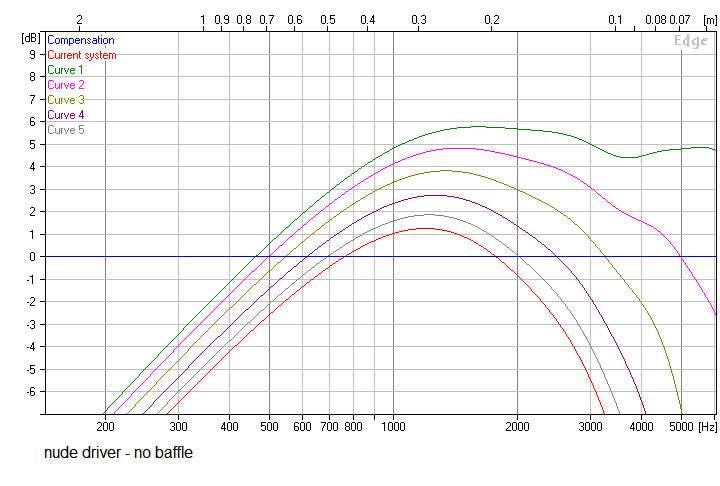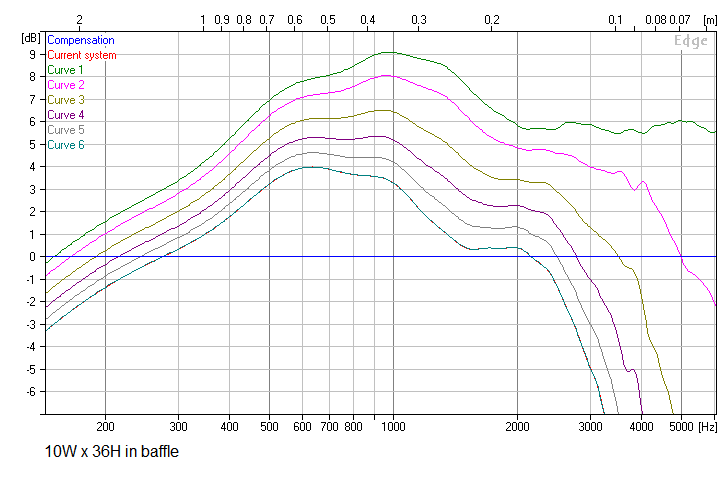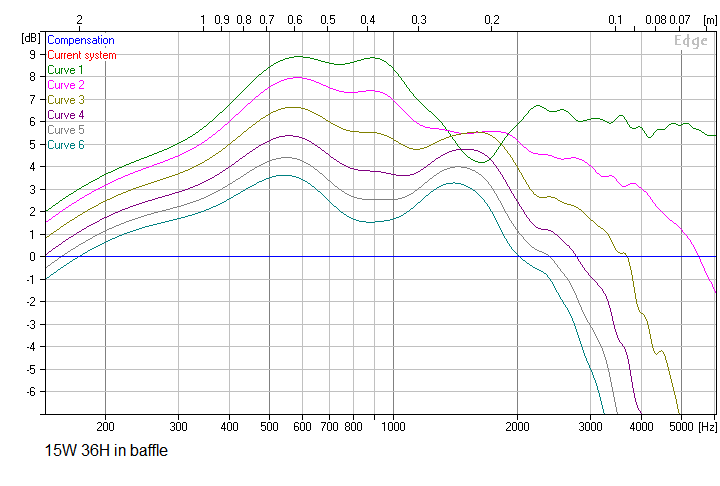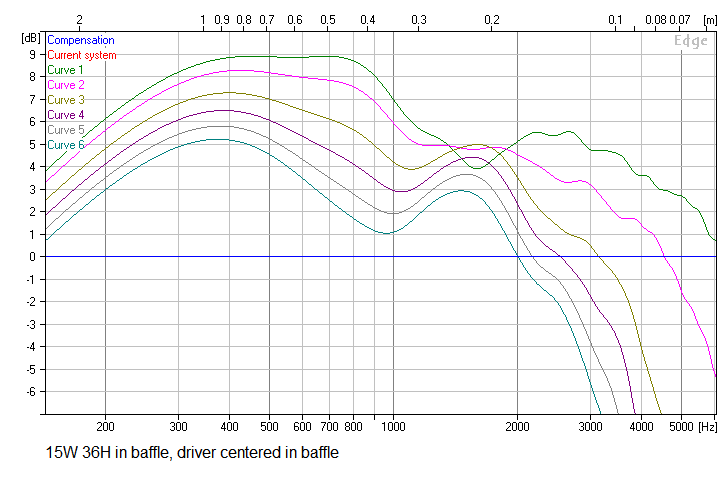It looks like GRS has picked up the technology of the B&G Neo line of planar drivers and Parts Express is now selling them. This is a great time to revisit what you might make out of this line of drivers. Here are some thoughts about how to best use the largest member of the lineup as a dipole midrange.
I've always wanted to get my hands on the Neo10 but never quite did, but have just ordered a pair of the GRS PT5010. It seems to be an almost exact clone, at least visually. I took a look at the response plot that GRS provides in the datasheet to get some clues about how I can best use this driver. I like to build dipole loudspeakers, and the PT5010 can potentially work as a midrange. I assume the response that GRS is providing in the datasheet is with infinite baffle loading:

I was hoping to cross over to it around 700 to 800 Hz, but the response is starting to sag there, with the SPL dropping down to under 90dB/W (the driver is rated at a nominal 94dB@2.83V).
To get a sense of what I might expect in a baffle of anything from zero (nude) to as large as I want to go I used the Edge to simulate some responses at a few angle up to 45deg off axis. I thought I would share what I found, which I think is indicative of how many drivers in planar baffles will behave as you vary the baffle size. Keep in mind that this is only the response of the baffle - you have to add it to what the response of the driver will be, e.g. its nearfield response. For that I will use the MFG curve for now until I can measure it myself.
First, let's look at the "no baffle" or "nude" response. It looks like this:

This has a very smooth response. The curves all follow each other, with only a bit of narrowing above 1.5 to 2k Hz. I would call this "CD like". There is very little sign of a classic "dipole peak". But since the low frequencies start to roll off just about 1kHz using the driver like this would only add to the downsloping response based on the MFG data.
OK, since I was planning to build a "slim" dipole system, how would the driver look in my narrow baffle? I tried out a 36" high, 10" wide baffle with the top edge of the driver at the top edge of the baffle. This what that looks like:

We can see that even this slim baffle has changed the response quite a bit. Now the response has a broad hump in it, centered around 1kHz. The result is that the response below that point has been brought up by a few dB. This would help to offset the losses from the driver in that region. OK, good so far.
Maybe we can do some of that same thing, but more of it, by using a wider baffle. Let's try going up to 15" W with the same baffle height and top-center driver position. Here is what that looks like:

Indeed, the response down to 500Hz has been brought up a bit more. But there is a new feature - a pinching and even crossing of some of the responses around 1.7kHz. This is exactly what you get when you use a baffle that is more than about twice the width of a driver and has been pretty well documented. It's not desirable to have this kind of response feature, because there is no way to correct for it in the crossover. This happened just by increasing the baffle width by a few more inches!
In fact, if you move the driver location to smack in the middle (horizontally and vertically centered) of the baffle, you will almost always get this kind of behavior:

Now the low frequency is well supported by the baffle, but the trouble spot remains, here at around 1.5kHz. It would be fine for a woofer but not for a midrange. This is why I feel that many wide baffle OB systems have built in problems. For instance the classic woofer plus fullranger in a large baffle - it is building in response issues that you cannot get rid of. Some of the Pure Audio Project systems come to mind, for example.
Usually I aim to implement a driver with as little a baffle as possible. As a result, some of my speaker systems are just drivers hung by wires. But that insures the driver responses are as smooth and CD like as possible.
But for this large planar driver it seems that the 10" wide baffle will work great. I hope to use it with a pair of 8" woofers below and a planar tweeter (probably the new GRS one) above, probably nude. It will also be visually "thin" which is helpful for dipole systems because the baffle will not block or interfere with the rear output, which you want to be able to let though so it can form that wonderful open soundstage that a good dipole system is known for.
I've always wanted to get my hands on the Neo10 but never quite did, but have just ordered a pair of the GRS PT5010. It seems to be an almost exact clone, at least visually. I took a look at the response plot that GRS provides in the datasheet to get some clues about how I can best use this driver. I like to build dipole loudspeakers, and the PT5010 can potentially work as a midrange. I assume the response that GRS is providing in the datasheet is with infinite baffle loading:
I was hoping to cross over to it around 700 to 800 Hz, but the response is starting to sag there, with the SPL dropping down to under 90dB/W (the driver is rated at a nominal 94dB@2.83V).
To get a sense of what I might expect in a baffle of anything from zero (nude) to as large as I want to go I used the Edge to simulate some responses at a few angle up to 45deg off axis. I thought I would share what I found, which I think is indicative of how many drivers in planar baffles will behave as you vary the baffle size. Keep in mind that this is only the response of the baffle - you have to add it to what the response of the driver will be, e.g. its nearfield response. For that I will use the MFG curve for now until I can measure it myself.
First, let's look at the "no baffle" or "nude" response. It looks like this:
This has a very smooth response. The curves all follow each other, with only a bit of narrowing above 1.5 to 2k Hz. I would call this "CD like". There is very little sign of a classic "dipole peak". But since the low frequencies start to roll off just about 1kHz using the driver like this would only add to the downsloping response based on the MFG data.
OK, since I was planning to build a "slim" dipole system, how would the driver look in my narrow baffle? I tried out a 36" high, 10" wide baffle with the top edge of the driver at the top edge of the baffle. This what that looks like:
We can see that even this slim baffle has changed the response quite a bit. Now the response has a broad hump in it, centered around 1kHz. The result is that the response below that point has been brought up by a few dB. This would help to offset the losses from the driver in that region. OK, good so far.
Maybe we can do some of that same thing, but more of it, by using a wider baffle. Let's try going up to 15" W with the same baffle height and top-center driver position. Here is what that looks like:
Indeed, the response down to 500Hz has been brought up a bit more. But there is a new feature - a pinching and even crossing of some of the responses around 1.7kHz. This is exactly what you get when you use a baffle that is more than about twice the width of a driver and has been pretty well documented. It's not desirable to have this kind of response feature, because there is no way to correct for it in the crossover. This happened just by increasing the baffle width by a few more inches!
In fact, if you move the driver location to smack in the middle (horizontally and vertically centered) of the baffle, you will almost always get this kind of behavior:
Now the low frequency is well supported by the baffle, but the trouble spot remains, here at around 1.5kHz. It would be fine for a woofer but not for a midrange. This is why I feel that many wide baffle OB systems have built in problems. For instance the classic woofer plus fullranger in a large baffle - it is building in response issues that you cannot get rid of. Some of the Pure Audio Project systems come to mind, for example.
Usually I aim to implement a driver with as little a baffle as possible. As a result, some of my speaker systems are just drivers hung by wires. But that insures the driver responses are as smooth and CD like as possible.
But for this large planar driver it seems that the 10" wide baffle will work great. I hope to use it with a pair of 8" woofers below and a planar tweeter (probably the new GRS one) above, probably nude. It will also be visually "thin" which is helpful for dipole systems because the baffle will not block or interfere with the rear output, which you want to be able to let though so it can form that wonderful open soundstage that a good dipole system is known for.
Attachments
Last edited:
Charlie,
I assume this is actually P/N PT5010?
Do you have crossover points in mind?
Bill
Hi Bill!
Oops, thanks for pointing that out - it's indeed the PT5010. I'm trying to correct this now.
I'm thinking of using it between 700Hz and 3kHz. This should work well with the other drivers I will be using to build the system.
I'm hoping to see non-linear distortion testing on this.. I know from past clones that distortion was often quite a bit worse.. (..apparently getting the spacing right for the diaphragm is difficult - and when you don't distortion goes way up.)
Nice to see the thread!
I am indeed also very curious about the distortion of this driver
Just wanted to post a link to some measurements of the real NEO10.
The Totem of Tone, an active 3-way dipole and active subwoofer
best regards,
Erik
I am indeed also very curious about the distortion of this driver
Just wanted to post a link to some measurements of the real NEO10.
The Totem of Tone, an active 3-way dipole and active subwoofer
best regards,
Erik
Nice to see the thread!
I am indeed also very curious about the distortion of this driver
Just wanted to post a link to some measurements of the real NEO10.
The Totem of Tone, an active 3-way dipole and active subwoofer
best regards,
Erik
Thanks for linking to that!
What I am planning is similar to Gerrit Boers "Totem of Tone" project, except that I will (or at least hope at this point) put the PT5010 at the top of a narrow planar baffle to lift the response at and just below 1kHz. Gerrit did some measurements of the Neo10 with "wings" but it is not clear where in the baffle he located the driver. This might be why he measured the "response dip".
Gerrit crossed over the Neo10 at what I would consider a rather low frequency of around 400Hz, LR4. I am planning to use 700Hz LR4, which should relieve the stress on the planar driver.
Below that I will use two woofers, the Peerless 830869 (click link for measurements at HifiCompass). I may roll off the lower woofer so that only the upper one is crossing over with the PT5010. The pair of 830869 will be used in parallel, which will raise the voltage sensitivity by 6dB to about 96dB@2.83V. Because the baffle is slim, I only plan to use these down to about 100-150Hz or so. Below that the dipole losses are too large. I will cross over to some kind of subwoofer at that point. I could use sealed (for a smaller room) or dipole subs.
Hopefully everything will all work out, but only time and measurements will tell.
On the 4th picture in the 2nd post of his thread there are drawings for the positioning of the NEO in the baffle. The whole process of his speakers is also documented in this (dutch) thread Di3+, the Totem of Tone - Pagina 8 - forum.zelfbouwaudio.nl
a lot of blabla, but also some more measurements.
Yes, I found 400Hz low as well, also because it requires compensation for dipole cancelation. Still it apparently works within reasonable distortion figures. It is probably a compromise, as IIRC Gerrit uses the 2 10" woofers for the 40-400Hz frequency, and did not want to go higher with these two woofers in parallel. He mentioned somewhere that a possible improvement could be to cut the lower woofer earlier, make it a 1.5 way, but he has no DSP channels left (he uses a 6 channel DSP from Hypex).
Best regards,
Erik
a lot of blabla, but also some more measurements.
Yes, I found 400Hz low as well, also because it requires compensation for dipole cancelation. Still it apparently works within reasonable distortion figures. It is probably a compromise, as IIRC Gerrit uses the 2 10" woofers for the 40-400Hz frequency, and did not want to go higher with these two woofers in parallel. He mentioned somewhere that a possible improvement could be to cut the lower woofer earlier, make it a 1.5 way, but he has no DSP channels left (he uses a 6 channel DSP from Hypex).
Best regards,
Erik
Here are the simulations for the woofers in the 10 inch wide baffle. 700Hz looks like a good place to cross them over. Also, the drivers (Peerless 830869) have a peak in 3rd order distortion around 1kHz that I want to avoid.
As shown in the third attachment, the PT5010 would be located at the top of the baffle above the woofers. I'm not quite seeing what Gerrit reported in his "with wings" measurements, but I am just modeling at this point. I could always drop back to a nude mounting if I need to.
As shown in the third attachment, the PT5010 would be located at the top of the baffle above the woofers. I'm not quite seeing what Gerrit reported in his "with wings" measurements, but I am just modeling at this point. I could always drop back to a nude mounting if I need to.
Attachments
Last edited:
Charlie, would contouring the baffle gain back some of the high end of the GRS?
As you remove baffle you will move through the responses back to the "nude" response.
The GRS PT5010 is NOT a tweeter. It is way too large for that. I will be using a separate tweeter.
Charlie, would contouring the baffle gain back some of the high end of the GRS?
To what degree can planars be EQ'd?
It's just the same as any other driver. It has Xmax and distortion related constraints on the low end, and dispersion/lobing constraints on the high end. Otherwise you can EQ all you want.
What is important to note is that EQ will effect the responses on all angles in the same way. This is why EQ cannot fix response pattern problems and why I strive for the "constant directivity" type of response, where the on and off axis responses track each other smoothly. These aren't flat, but can be EQd to flat and the CD behavior will be preserved.
The other design aspect that I should probably borrow/adapt from Gerrit's system is his use of a separate panel for the woofers that is not attached to the rest of the speaker, except at the ground. If you look closely at the pics of Gerrit's system you can see that the Neo10 and tweeter are on their own "stand". This decouples these drivers from the vibrations generated by the woofers. It's a very good idea to do this, and it is why I have hung drivers by wires in past experimental systems, since that decouples everything.
Yes, exactly. This is why I always try to measure potential drivers in the nude, hanging by wires at least 1m off of the ground. It's easier because the floor bounce is either absent or much reduced. When I do that outdoors I can get very high resolution (e.g. 50Hz) data that shows lots of high Q features that typical indoor measurements (with e.g. 200Hz resolution) will miss or smooth out.
Wow, this driver is a total PITA to mount! There is only a slim bezel around the outside of the frame with four mounting holes. But also sticking up from the bezel are all the screws and nuts used to hold the driver together. Crap, that is going to be a lot of work unless I can jury rig something to hold it in place. Now I see why Gerrit just taped on some pieces of cardboard!
Attachments
Wow, this driver is a total PITA to mount!
Here Dan back-mounted with a chamfer edge on the front:
Introducing: Echelon -
Techtalk Speaker Building, Audio, Video Discussion Forum
I could also envision using *3 thin boards in a sandwich configuration.
*or perhaps 2 and a viscoelastic layer in the middle.
Last edited:
- Home
- Loudspeakers
- Multi-Way
- Using the GRS PT5010 (Neo10 clone) as a dipole midrange













